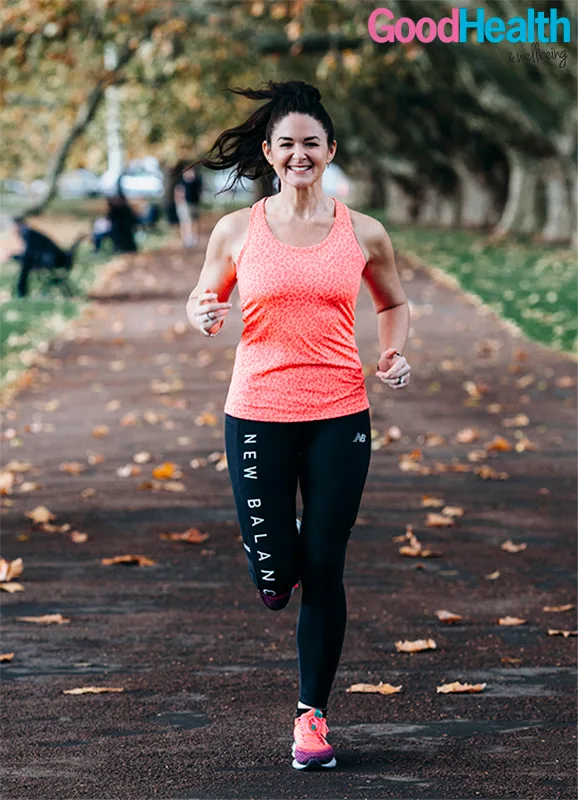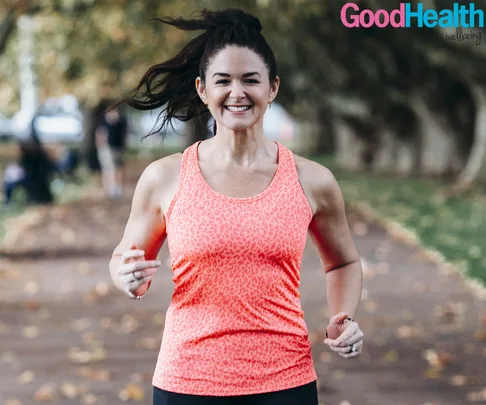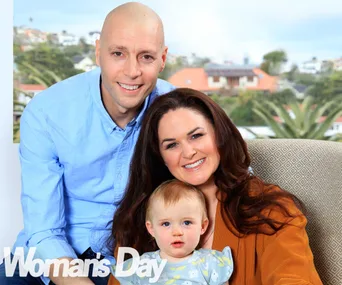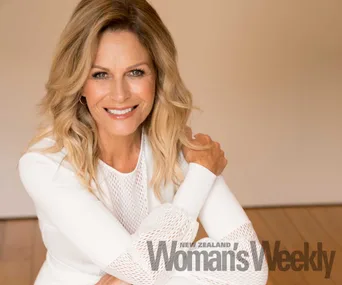On January 10 last year, Janelle Brunton-Rennie and her husband Kurt celebrated their third wedding anniversary. Their little girl, Sage, had just turned four months old, and Janelle was looking forward to a wonderful year ahead.
The following day, Kurt came out of the shower, prodded his stomach where his spleen was, and asked, “Do you think this feels a little bit hard?” Janelle casually replied, “Yeah, you should get that looked at,” thought nothing of it, and went off to work.
That afternoon she got a call from Kurt, who had gone to see his doctor, and was heading down the road for an ultrasound. From there, things rapidly unravelled. After a CT scan on the Friday, the couple got a call to go to the doctor’s and get the results on Saturday evening.
“The doctor was mucking around and I looked him square in the eye and said, ‘Just tell us. Does my husband have cancer or not?’ He looked at us and said, ‘Yes, your husband has lymphoma and it’s very progressed,'” the 36-year-old says.
It was the news no couple wants to hear.
Janelle and Kurt held hands, walked past the receptionist who clearly already knew and kept her head down, got into the car and burst into tears.
At 41, Kurt was diagnosed as having large diffuse B-cell non-Hodgkin’s lymphoma. After six rounds of chemotherapy involving R-CHOP and Methotrexate, he had the scan that was meant to show he was now in remission. Instead, it showed there were three tumours growing very quickly and aggressively.
While Kurt underwent R-ICE chemotherapy, Janelle began investigating plan B options.
She discovered there was an option in Boston in the US called CAR-T immunotherapy treatment, however the costs were huge. When the R-ICE treatment didn’t work for Kurt, then the third line of chemotherapy intervention, DHAP, also failed, Kurt was told his condition was terminal and their next step was hospice.
“I told them we were going to Boston. The two nurses looked at me with pity and said it’d be very unlikely that we’d be able to get him there; he only had weeks to live. I’m a don’t-tell-me-no person, so I said, ‘I’ll get him to Boston and get him his treatment, you watch me.'”
In Boston, Kurt’s T cells were sent to Seattle to be genetically engineered into killer cells. The day Kurt got those T cells back, Janelle genuinely thought their nightmare was finally over.
“I thought, ‘This is the best technology in the world, we’re through it.'”
When Kurt had a four-week scan to show how he was doing, it showed that 90 per cent of the disease was gone. But Janelle remembers looking at that scan and seeing a tiny area between his liver and spleen lighting up like a Christmas tree – and it terrified her.
“It was this tiny area, the size of a 10 cent coin, but it looked ferocious. It was the brightest I’d ever seen.”
By now it was Thanksgiving and the US was shutting down for the holiday period, but it was three weeks that Kurt didn’t really have. A repositioning scan on December 26 – which they were hoping was going to show CAR-T action – instead showed innumerable tumours, and a greatly progressed disease.
“All we could do was try and get him home safely,” remembers Janelle.
Kurt flew out of Boston the next day, with Janelle meeting him at the airport on the morning of New Year’s Eve. Within eight days, on January 7, he passed. It was almost a year to the day from when their nightmare first started.
Now a widow with a business to run and a young daughter to raise on her own, it would be easy for Janelle to feel helpless, but she didn’t want their nightmare to be in vain.
“I haven’t had to walk this extremely painful path for no one to benefit from this. It has to be about something greater than myself or Kurt or our tragedy. If I can use our own journey to help other people, then it doesn’t make it worth it but in some way it means I can create a legacy for Kurt – that our gut-wrenching journey is not in vain.”
She has decided to run this year’s Auckland Marathon in honour of Kurt. That distance, 42.2km, may sound challenging but for Janelle, it’s nothing compared to the physical pain she watched her husband endure.
Janelle will be running in an effort to raise funds for The Malaghan Institute of Medical Research, who are fundraising to bring CAR-T immunotherapy treatment to New Zealand later this year so that families who are out of options, like Kurt and Janelle, can have a shot at beating a devastating terminal blood cancer diagnosis while still being at home with their loved ones by their side.

The exercise is also giving Janelle an outlet to help her cope through a time of grief.
“I almost find running to be a form of moving meditation,” she says.
“Before Kurt’s cancer journey or the resulting grief journey, if I had a problem and went for a run, I’d come back and it would feel like there was no more problem. For me, it’s a beautiful way to work through things and get anything out. Some days that might just be a release through a run and other days I have to train out some frustration or anger. But it makes my body feel good.”
Kurt’s brother will also be doing the full marathon, his mum Sue’s going to run the half, and some of Kurt and Janelle’s workmates and friends are also running, so there will be a team of them #runningforkurt and raising funds for The Malaghan Institute.
In New Zealand, six people are diagnosed with blood cancer every day, and 70 people a year die from terminal blood cancer when they’ve run out of treatment options. Janelle wants to try and change those statistics.
“By raising funds, it’s an investment for every single person in our country. If 80 per cent of those 70 New Zealanders can be saved through immunotherapy, then it’s worth it. Going around the other side of the world for CAR-T treatment is not achievable for most, and if this treatment had been available for us, Kurt would’ve bought another four months of living in New Zealand with his daughter rather than four months across the other side of the world.”

Despite the circumstances surrounding it, Janelle’s excited for the run; not only is she raising funds for The Malaghan Institute, but is once again able to enjoy something that’s always been a part of her life.
“I know Kurt would be happy knowing I was able to run again because he knew how therapeutic I find it,” she explains. Janelle also encourages us all to live with “a bit more Kurt”.
“Kurt never sweated the small stuff. He always showed up with this great big smile, he lit up a room and packed a huge amount of life into his 41 years.
“I often ask myself, ‘What would Kurt do?’ because he would always live in the moment. Living in that magic space that Kurt managed to occupy effortlessly is the best way I could honour him. Living life with a bit more of Kurt’s attitude is not just something that benefits me, it’s something that everyone could learn from.
“If I can help inspire people to live in that moment more, to appreciate those small things more, to not sweat the small stuff as much, then in some way it feels like we’re all honouring Kurt, and that’s an immense legacy to leave.”
After all, Janelle says that when you’re sitting there with someone on their deathbed in their final days, you don’t talk about the stuff you have bought or your business turnover.
“You talk about the magic memories you’ve made together, which always include travel, sunrises, sunsets, the birth of your children, and your wedding day. Do all of those special things with all of the special humans around you, because that’s the stuff that counts.”
Janelle’s tips on how to help others navigating the cancer journey
Reach out: This is the most important thing you can do. If you have friends or loved ones going through a cancer journey right now, reach out in a text message – without the need for a response either – and just tell them you’re thinking about them and you’re sending lots of love and strength.
Drop over food: Don’t do it unannounced though – that’s really important.
Hold space for people to talk: Know that you don’t have to fix things, all you have to do is listen.
Follow her journey: Check out Janelle on Instagram @janellebruntonrennie #runningforkurt
Janelle’s marathon preparation
Janelle’s training programme includes four runs a week – two smaller runs, a medium run and a longer run.
Shoe Clinic has given her two pairs of shoes. One pair is more supportive and has plenty of memory foam, whereas the other pair helps with shorter runs and tempo running. By switching between the two pairs, Janelle’s maximising what she can get out of them and giving the memory foam on her longer-run shoes a greater chance of recovery, so in turn they last longer.
Socks are also important. Janelle’s invested in six pairs of Dry Max socks because she’s prone to blisters. She’s got different socks for her shorter runs, medium runs, and proper blister preventative socks for her longer runs.
Stretching and foam rolling for fascia release helps to prevent Janelle’s hip flexors from getting tight during the run. If she needs to do more spot targeted fascia release, she finds rolling on a cricket ball to be more effective, particularly on her glutes.
Janelle gets regular acupuncture because she finds it to be the best way to work on any tight muscles or ligaments that need to be loosened up.
To help Janelle fundraise for The Malaghan Institute of Medical Research, head to aucklandmarathon2019.everydayhero.com/nz/janelle-brunton-rennie




